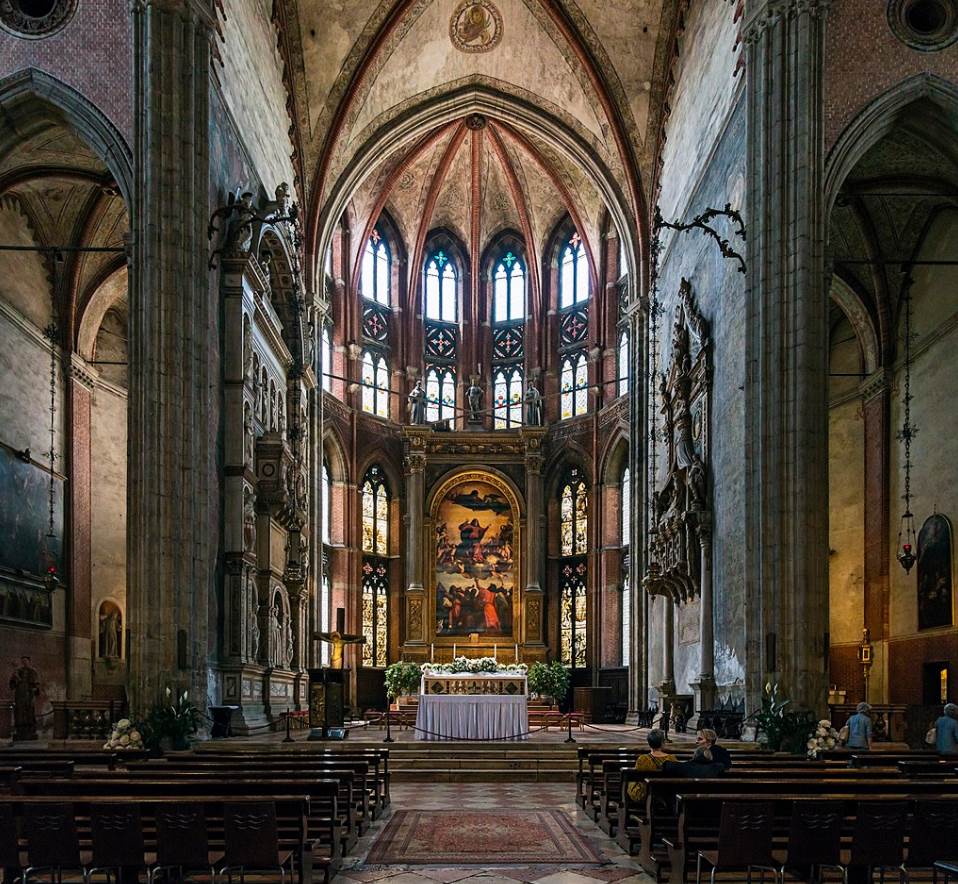Tiziano Vecelli (1490-1576) was already an established master at the height of the High Renaissance (the 1490s-1527), a brief period in history in which incredible talent converged in Italy.
This was an incredible period in art history when some of the most amazing Renaissance masterpieces were produced. This includes several paintings by Titian as well.
Considered to be one of the greatest masters of the Venetian School of the 16th century, Titian left a permanent mark on the city of Venice with incredible works of art.
In this article, we’ll take a closer look at some of the most interesting facts about the Pesaro Madonna, one of the artworks by the Renaissance master that still decorates a famous church in Venice today.
1. It was painted while the artist was (presumably) in his thirties
Titian became the artist of his contemporary Giorgione (the 1470s-1510) in the early 16th century and both artists established the Venetian School. Although he was initially an assistant of Giorgione, he was already considered to be a master in his own right as well.
He became the leading artist in the region following the death of his colleague in 1510 and firmly established himself in Venice after coming back from a commission in Padua in 1512.
Although his exact date of birth remains a mystery, modern art historians place it somewhere between 1588 and 1590. Titian completed the Pesaro Madonna between 1519 and 1526 which means he was probably in his early thirties when he started.
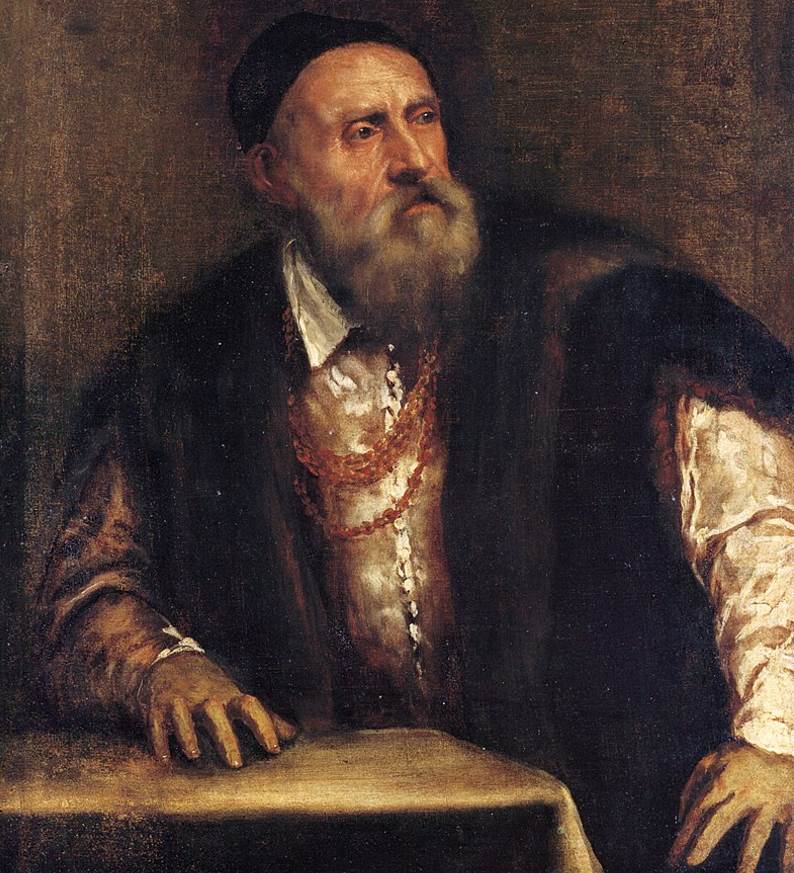
2. It was commissioned by a rich Bishop who was active in Cyprus
The painting’s name, the “Pesaro Madonna” or “Madonna of Ca’ Pesaro,” was derived from the man who commissioned the work, Jacopo Pesaro. He was the Bishop of Paphos at the time, a city on the island of Cyprus just south of Italy.
He was a versatile man who was also appointed as the commander of the Papal fleet by Pope Alexander VI in 1502. This means that he was able to amass a lot of wealth which allowed him to commission monumental works of art such as this one.
The Pesaro family already acquired a chapel at the Basilica di Santa Maria Gloriosa dei Frari in Venice, commonly referred to as the “Frari,” in the year 1518. This painting was commissioned to become the chapel’s altarpiece.
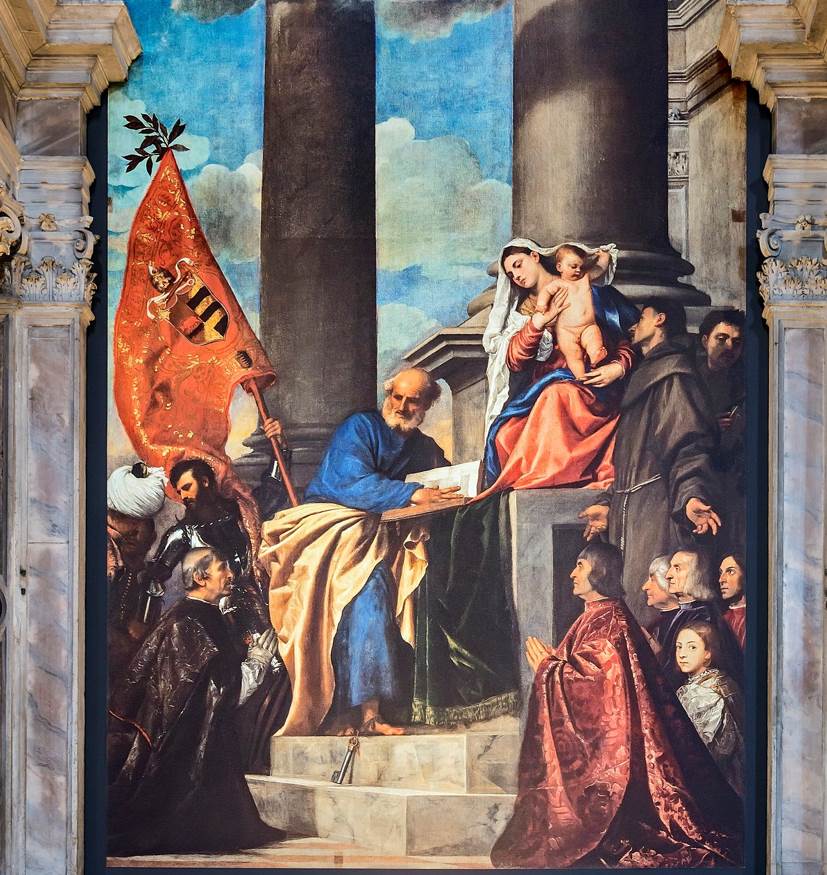
3. The painting depicts Jacopo as he is presented to the Virgin by Saint Peter
Jacopo Pesaro was depicted by Titian in a humble kneeling position, and that’s because he is being presented the Virgin Mary by none other than Saint Peter. The keys of heaven or “Saint Peter’s Key” can be seen on the steps which presumably lead to the Heavens above.
The Virgin is positioned on top of the stairs which is a reference to her celestial role as the “Madonna della Scala” or “Madonna of the Steps.”
The kneeling position is similar to how the patrons in the paintings of Early Netherlandish master Jan van Eyck (1390-1441) were depicted. Some examples are “The Madonna of Chancellor Rolin” (1435) and “Virgin and Child with Canon van der Paele” (1434-1436).

4. It features several symbols referring to Jacopo’s life and achievements
The man is not only seen kneeling along with several of his family members besides him, but it also features several elements that refer to the life and profession of Jacopo Pesaro.
On the left-hand side, we can see a kneeling knight who is holding two captives, a Turk and a Moor. This is most probably a reference to a victory by Pesaro over the Turks in 1502 as commander of the Papal fleet.
The red flag that the knight is holding features the coat of arms of both the Papal States and the Pesaro family. The architectural details are included to emphasize the man’s wealth and power.

5. It’s still located in the same location it was commissioned for
The chapel acquired by the Pesaro family in the Frair Basilica in Venice is one of the many chapels inside this remarkable church. It’s the fourth chapel on the left side of the nave.
One of the most amazing facts about the Pesaro Madonna is that it still resides in the same location today, over 500 years after it was commissioned by Jacopo Pesaro.
The only time it left its original location was during a restoration project that took place following the devastating earthquakes in Italy in 2012 (it was replaced by a copy during this period).
It can still be admired in the chapel today because it was re-inaugurated during a big party on September 21, 2017, completely restored, and returned to its former glory as well.
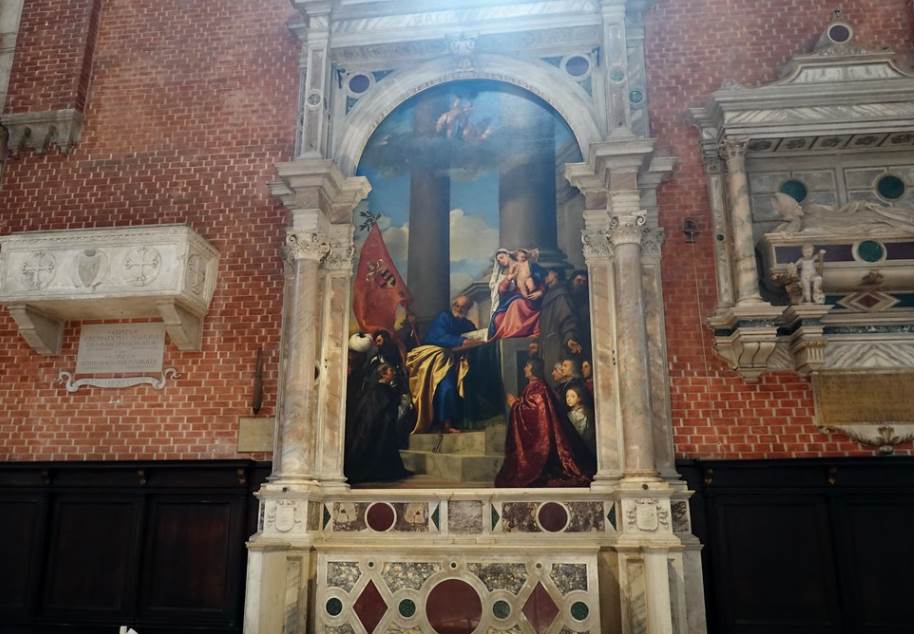
More interesting facts about the Pesaro Madonna by Titian
6. Titian spent about 7 years completing this monumental work of art and that’s not just because the Venetian master was overwhelmed by orders from rich patrons, but also because it’s pretty big.
This monumental oil on canvas painting has dimensions of 4.88 × 2.69 meters (16 × 8.8 feet).
7. The Pesaro Madonna wasn’t the only painting that Jacopo Pesaro commissioned from Titian. He already commissioned another work from him called “Jacopo Pesaro being presented by Pope Alexander VI to Saint Peter” between 1506 and 1511.
He commissioned this painting to commemorate his naval victory over the Turks and the retaking of Leftaka (a Greek island) in 1502, a year before the Ottoman–Venetian War (1499–1503) ended. This painting is located at the Royal Museum of Fine Arts, Antwerp, Belgium.

8. By squeezing Jacopo Pesaro and 4 of his family members into the bottom right corner of the painting he enabled the possibility to increase the sense of motion of all the other figures.
When you pay close attention to all the other figures, you can see that all of them are moving around, a sense of motion that was used by Baroque artists a century later. This makes this remarkable work of art one of the most revolutionary paintings of the early 16th century.
9. The model for the Virgin in this painting is believed to have been Titian’s first wife Cecilia. She was a barber’s daughter from the artist’s hometown of Cadore.
They already had two sons before this painting was completed named Pomponio and Orazio. His wife, unfortunately, died in the year 1530, presumably during childbirth.
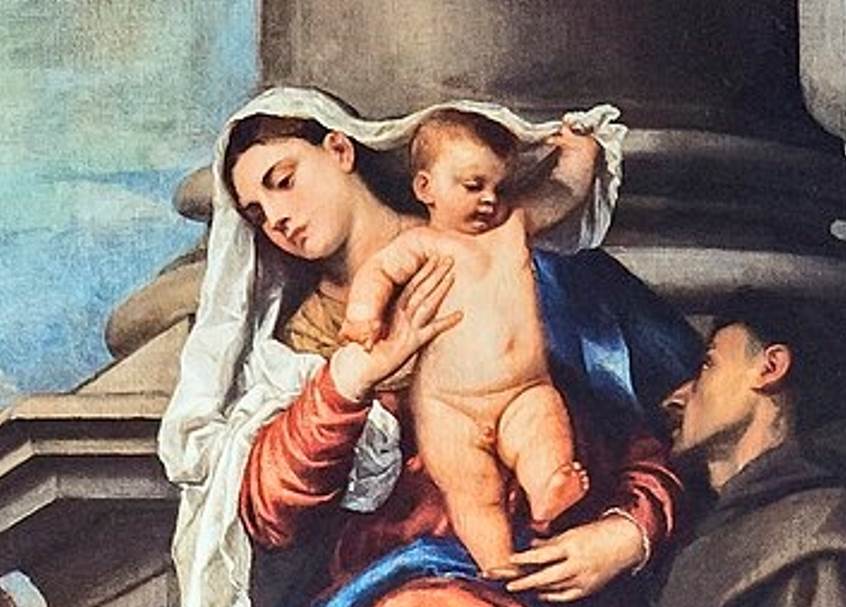
10. The two friars just above the Pesaro family members have been identified as Saint Francis of Assisi and Saint Anthony of Padua. Both were Franciscans and they were included because the church of Santa Maria Gloriosa dei Frari in Venice is Franciscan as well.
11. Titian wasn’t able to make up his mind about the two immense columns that he included in the center of the painting. X-ray analysis has revealed that he painted several other versions of pilasters before he included these two mastodonts of columns.
This was also a unique feature in Renaissance painting because the figures are pretty much dwarfed by these large architectural elements.
12. The Frari Basilica isn’t an architectural highlight in Venice by itself, but the treasure inside makes it almost a must-visit building if you plan to visit this remarkable city.
Not only did Titian complete the Pesaro Madonna but he also painted the main altarpiece inside the church called “The Assumption of the Virgin” (1515-1518). This work can be described as his breakthrough as a master in Venice. This is just one of the countless artworks located inside this church.
There are also several funerary monuments located here, including the funerary monuments of both Jacopo Pesaro and Titian themselves.
